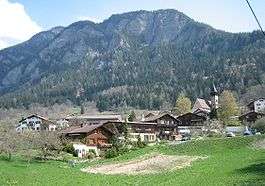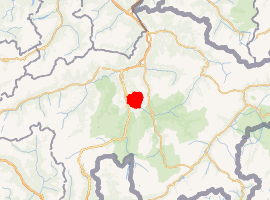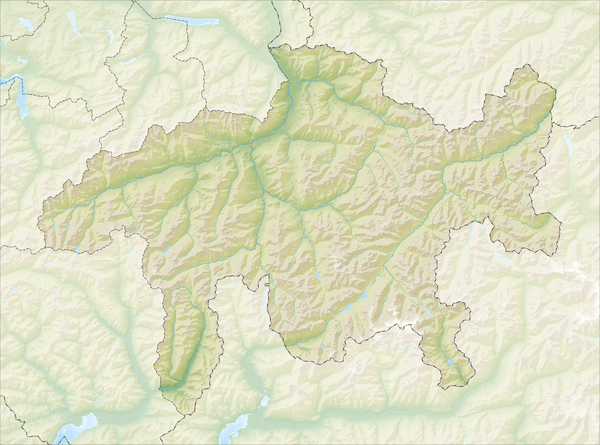Scharans
Scharans (Romansh: Scharons) is a municipality in the Viamala Region in the Swiss canton of Graubünden.
Scharans | |
|---|---|
 | |
 Coat of arms | |
Location of Scharans 
| |
 Scharans  Scharans | |
| Coordinates: 46°43′N 9°27′E | |
| Country | Switzerland |
| Canton | Graubünden |
| District | Viamala |
| Area | |
| • Total | 1,459 km2 (563 sq mi) |
| Elevation | 760 m (2,490 ft) |
| Population (2018-12-31)[2] | |
| • Total | 789 |
| • Density | 0.54/km2 (1.4/sq mi) |
| Postal code | 7412 |
| SFOS number | 3638 |
| Surrounded by | Almens, Fürstenau, Sils im Domleschg, Vaz/Obervaz |
| Website | www SFSO statistics |
History
Scharans is first mentioned in 1200 as agrum Schraunis.[3]
Geography

Scharans has an area, as of 2006, of 14.3 km2 (5.5 sq mi). Of this area, 26.1% is used for agricultural purposes, while 62% is forested. Of the rest of the land, 2.9% is settled (buildings or roads) and the remainder (9%) is non-productive (rivers, glaciers or mountains).[4]
Before 2017, the municipality was located in the Domleschg sub-district, of the Hinterrhein district, after 2017 it was part of the Viamala Region.[5] It consists of the haufendorf (an irregular, unplanned and quite closely packed village, built around a central square) of Scharans and the hamlets of St. Agata, Stufels, Parnegl and Prin. It is located on a low terrace on the right hand side of the Albula and Hinterrhein rivers.
Demographics
Scharans has a population (as of 31 December 2018) of 789.[6] As of 2008, 5.1% of the population was made up of foreign nationals. Over the last 10 years the population has grown at a rate of 14.9%.[4]
As of 2000, the gender distribution of the population was 49.1% male and 50.9% female.[7] The age distribution, as of 2000, in Scharans is; 267 people or 8.7% of the population are between 0 and 9 years old. 155 people or 5.1% are 10 to 14, and 281 people or 9.2% are 15 to 19. Of the adult population, 460 people or 15.0% of the population are between 20 and 29 years old. 541 people or 17.6% are 30 to 39, 462 people or 15.1% are 40 to 49, and 385 people or 12.5% are 50 to 59. The senior population distribution is 209 people or 6.8% of the population are between 60 and 69 years old, 189 people or 6.2% are 70 to 79, there are 103 people or 3.4% who are 80 to 89, and there are 17 people or 0.6% who are 90 to 99.[8]
In the 2007 federal election the most popular party was the SVP which received 37.6% of the vote. The next three most popular parties were the SPS (34.4%), the FDP (15.8%) and the CVP (6.6%).[4]
In Scharans about 74.9% of the population (between age 25-64) have completed either non-mandatory upper secondary education or additional higher education (either university or a Fachhochschule).[4]
Scharans has an unemployment rate of 1.08%. As of 2005, there were 32 people employed in the primary economic sector and about 15 businesses involved in this sector. 21 people are employed in the secondary sector and there are 6 businesses in this sector. 236 people are employed in the tertiary sector, with 23 businesses in this sector.[4]
From the 2000 census, 1,180 or 38.4% are Roman Catholic, while 1,510 or 49.2% belonged to the Swiss Reformed Church. Of the rest of the population, there are less than 5 individuals who belong to the Christian Catholic faith, there are 76 individuals (or about 2.48% of the population) who belong to the Orthodox Church, and there are 60 individuals (or about 1.96% of the population) who belong to another Christian church. There are 19 (or about 0.62% of the population) who are Islamic. There are 11 individuals (or about 0.36% of the population) who belong to another church (not listed on the census), 135 (or about 4.40% of the population) belong to no church, are agnostic or atheist, and 78 individuals (or about 2.54% of the population) did not answer the question.[8]
The historical population is given in the following table:[3]
| year | population |
|---|---|
| 1803 | 336 |
| 1850 | 416 |
| 1900 | 439 |
| 1950 | 480 |
| 1960 | 473 |
| 2000 | 817 |
Languages
Most of the population (as of 2000) speaks German (95.7%), with Romansh being second most common ( 2.1%) and Italian being third ( 0.9%).[4]
| Languages in Scharans | ||||||
| Languages | Census 1980 | Census 1990 | Census 2000 | |||
| Number | Percent | Number | Percent | Number | Percent | |
| German | 484 | 82.59% | 628 | 89.46% | 782 | 95.72% |
| Romanish | 69 | 11.77% | 22 | 3.13% | 17 | 2.08% |
| Italian | 14 | 2.39% | 18 | 2.56% | 7 | 0.86% |
| Population | 586 | 100% | 702 | 100% | 817 | 100% |
Heritage sites of national significance
The Haus Bardill (formerly known as Haus Gees) is listed as a Swiss heritage sites of national significance.[9]
References
- "Arealstatistik Standard - Gemeinden nach 4 Hauptbereichen". Federal Statistical Office. Retrieved 13 January 2019.
- "Ständige Wohnbevölkerung nach Staatsangehörigkeitskategorie Geschlecht und Gemeinde; Provisorische Jahresergebnisse; 2018". Federal Statistical Office. 9 April 2019. Retrieved 11 April 2019.
- Scharans in German, French and Italian in the online Historical Dictionary of Switzerland.
- Swiss Federal Statistical Office accessed 05-Oct-2009
- Swiss Federal Statistical Office - Amtliches Gemeindeverzeichnis der Schweiz - Mutationsmeldungen 2016 accessed 16 February 2017
- Swiss Federal Statistical Office - STAT-TAB, online database – Ständige und nichtständige Wohnbevölkerung nach institutionellen Gliederungen, Geburtsort und Staatsangehörigkeit (in German) accessed 23 September 2019
- Graubunden in Numbers Archived 2009-09-24 at the Wayback Machine (in German) accessed 21 September 2009
- Graubunden Population Statistics Archived 2009-08-27 at the Wayback Machine (in German) accessed 21 September 2009
- Swiss inventory of cultural property of national and regional significance Archived 2009-05-01 at the Wayback Machine 21.11.2008 version, (in German) accessed 05-Oct-2009
| Wikimedia Commons has media related to Scharans. |